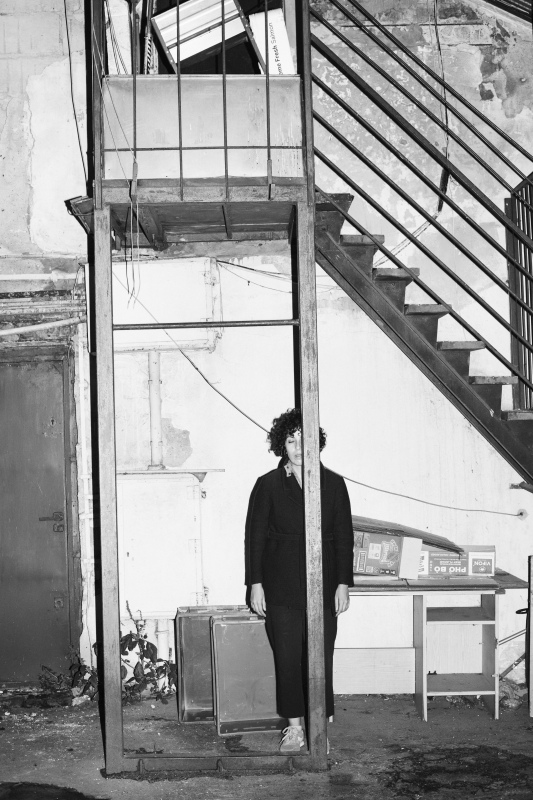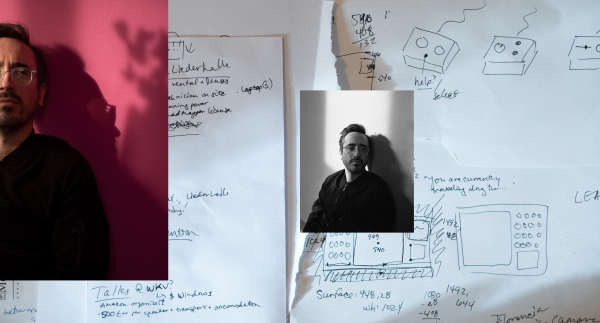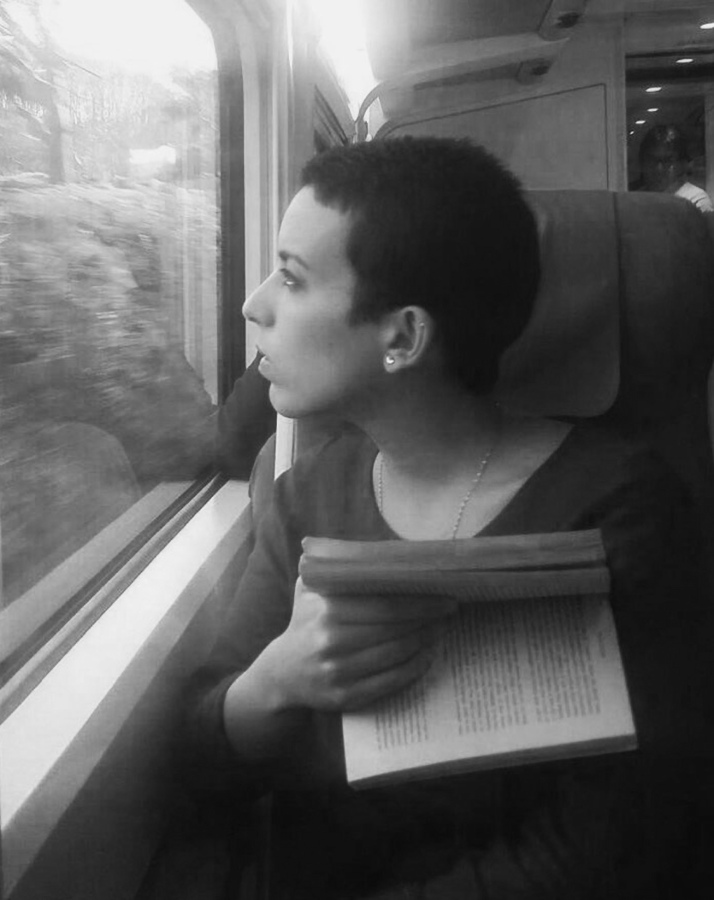Intruding in history and space
Noor Abed in conversation with Klara Czerniewska-Andryszczyk
-
How did your residency at U–jazdowski come about?
- For several years, I had followed Ika Sienkiewicz-Nowacka’s work and her collaboration with Palestinian artists with great interest. In early 2020, I received an email from her inviting me to apply. I submitted an application and it worked out. My residency at Ujazdowski Castle was scheduled for three months, from June to September 2020. Given that it was the time of peak Covid, travelling was impossible. Together with Ika, we decided to start a virtual residency in July, in the hope that I would be able to travel later. A virtual residency was not easy, but I tried to use the time to work on my papers to travel. As the borders were still closed in Palestine, I managed to get on one of the evacuation trips that the Ministry of Foreign Affairs had organised at that time. Despite all the formalities and the uncertainty of travelling, I finally made it to the Castle on 30 August.
-
What is the biggest benefit of the residency?
- I believe that the research-oriented structure of the U–jazdowski residency is very important. It gave me the space and time I needed to go deeper into my work, and to connect with the surroundings and with the other residents. I worked at my own pace, without being pushed to produce anything at the end of my time there. The ‘research period’ is a very laborious part of creating an artwork, and it is essential to give it all the time it needs. This approach, already embedded in the residency structure, was my biggest gain.
-
What were you doing while still in Palestine?
- Apart from working on my papers to travel, I was busy planning a film production and then shooting for my work, which I had to get done before I left. I shot using an analogue super 8mm camera in Palestine, and while on the residency in Warsaw, I managed to process the films and start editing. The final work will be presented in May next year, at Ika’s exhibition Everyday Forms of Resistance.
-
How does the topic of the exhibition relate to your own practice?
- The title of the exhibition comes from the theme of my residency, which I strongly relate to. In my work in general, I attempt to observe everyday life and highlight the absurdities of it. I think it’s crucial to retain the ‘absurdity’ of the absurd, and not to normalise it, especially in the context of where I come from. As for the exhibition, my work aims to create a new aesthetic form, to reawaken latent stories from Palestinian folklore: ones that are mainly based around water wells and their connection with disappearance. I am interested in placing this alternative narration as a form of resistance against the dominant political narratives of colonialism and pertaining to social structures. I try to answer the question about how folk tales can become an emancipatory tool, used to reclaim community and land that have been seized by direct colonialism and neoliberal hegemonies.
-
How do you achieve this in this particular film?
- I choreographed scenes and filmed them in an ancient location from the Roman era, where there is a huge water well that is now empty. It is located in the village of Al-Jeeb, northwest of Jerusalem. The final work will combine choreographed staged scenes and found footage, while the narration comes from a collage I created while researching Palestinian folk tales. Because the work was shot on Super 8 film, it has an archival feeling to it. I am hoping that when someone looks at it, they won’t necessarily recognise when it was made.
-
Sounds fascinating!
- The images I am interested in creating touch upon the daily life of a community: to get a sense of ritual and uncover the community’s relation to the surrounding landscape.
- It harks back to Palestinian Militant Cinema, and its strong emergence linked to the colonial project and the war in the 1960s and 70s. The Palestinian Film Unit produced crucial works at that time, featuring revolution, fighters, their solidarity, and anti-colonial narratives. On the other hand, if you look at images from Palestine before the 1948 war, you realise that most of them are taken by orientalists or colonialists who came to the land, took photos to use in the support of their colonial narratives. I am interested in this historical relationship between image-making and colonialism. I am working on reconstructing that, creating images from Palestine, about or for Palestine, but from us, from me. The final image will seem timeless – you don’t know if it was made now, or sometime in the past... and I try to insert it within the existing historical narratives.
-
Do you consider yourself a creator of new myths?
- I love mythologies. I think of them as a collective dream or public imagination. There is a whole social, economic and political structure inside mythologies that I think is interesting to reawaken.
-
You studied in the US. What made you come back to Palestine?
- I finished my Bachelor’s degree at the International Academy of Arts in Ramallah – Palestine, then I moved to Los Angeles for my Master’s. I finished an MFA in photography and media from the California Institute of the Arts (CalArts) in 2015. Afterwards, I moved to New York, where I was a participant in the Whitney Museum Independent Study Program (ISP). From there I moved to Lebanon for a Home Works Programme fellowship, and then moved to Egypt, where I was working on a film, before coming back home to Palestine.
- Living in the U.S was challenging on many levels, especially negotiating the notion of ‘identity politics’. Every work I made—regardless of the content or form—was interpreted as coming from my identity. I struggled with the immediate frame I was given as an Arab brown-skinned woman, as some addressed me. Although I am very interested in questions of identity, I do not respond to ‘identity politics’ as an empty gesture of recognition that results in reinforcing a classic image of politics as a war of competing identity groups. The question of identity is not just, “what is yours?” but also, “what is all of ours?” I could talk endlessly about this...
-
How did you end up with the Documenta team?
- Oh! Documenta was an unexpected event. It was 2012, I was a bachelor’s student at the Art Academy in Palestine, when the Goethe Institute announced an open call for fellowships in Documenta. I applied through the open call, and unexpectedly got it. I worked with the curatorial team at the Maybe Education and Public Programme department as an assistant coordinator for one of the projects. I think Documenta was an eye-opening experience for me, as it made me aware of the backstage, the infrastructure of such a large-scale art festival. I believe I kept digesting it for years, and it is interesting to think how much it affected my practice later on. It seemed to have led me – maybe unconsciously – to other curatorial practices I have done, such as the School of Intrusions, an independent educational platform in Palestine, which I co-founded last year with an independent curator and friend of mine, Lara Khaldi.
-
Can you tell me more about the school?
- The School of Intrusions was inspired by Paulo Freire’s The Pedagogy of Freedom, and his idea of ‘education as a form of intervention in the world’. I associate the word ‘intervention’ with performativity, movement, eruptions, change and touching upon surfaces of social structures and/or infrastructures.
- The School of Intrusions is an experimental educational platform that aims to develop a space for conversation without excluding, and going beyond art exhibitions, conferences, and temporary initiatives. It’s a space for collaboration through independent mutual practices of ‘education’ seen as a form of intervention; one that is radical and self-aware. Through collective thought and its correlative action, the school focuses on experiential site-based learning (or unlearning), the formation of communities, collectivism, and alternative economies: it considers the city of Ramallah as a communal space, where participants meet in private and public spaces in the city, practicing the notion of ‘commons’ in their everyday work and life. We strive to stimulate our collective imagination towards unlearning the dominant ideologies, interlacing the neoliberal economy and colonialism.
-
Who are you funded by?
- We ran the first edition with no funding. It will be something to consider for the second edition. However, as much as I believe the project should benefit from funding, it should not be dependent on it. The school is free of charge and all resources are shared equally. Its structure assumes no space, no walls, and no institutional affiliation.
- Warsaw – Athens, 13 November, 2020


